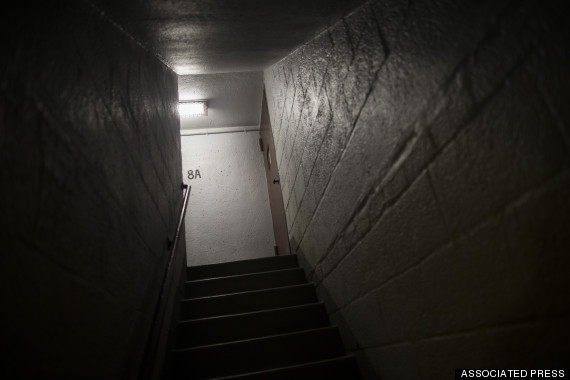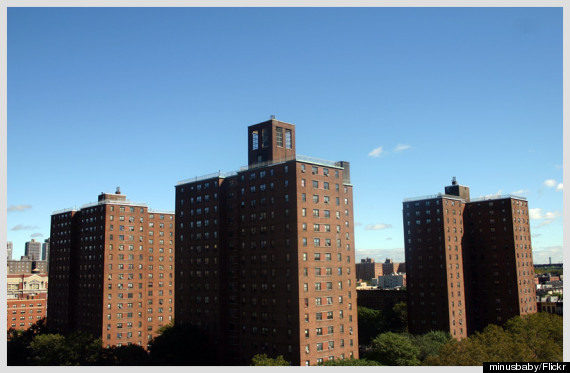NEW YORK -- The stairways inside many of New York City’s public housing projects are dark when police patrol them, the lights in disrepair like so much else in the buildings.
“Those stairways are scary places,” Greg Donaldson, an associate professor at John Jay College of Criminal Justice, told The Huffington Post. Donaldson has regularly accompanied police on what are called “vertical patrols,” in which two officers will go to the roof of a public housing building and then descend slowly through the stairs.
“You’re turning from one landing to the next,” he said. “There aren’t long sightlines.”

Police say that vertical patrols help prevent crime in the places where it so often lurks, while critics blame the tactic for unconstitutional police stops and arrests. Either way, vertical patrols have sometimes spelled tragedy for innocent residents -- most of whom were black -- and for police officers themselves.
About three weeks ago, 28-year-old Akai Gurley and his girlfriend, Melissa Butler, 26, left Butler’s seventh-floor apartment inside the Louis Pink Houses in the East New York neighborhood of Brooklyn. The elevator wasn't working, so the couple entered the dark stairwell.

At the same time, two rookie police officers on a vertical patrol entered the stairwell from the eighth floor. Officer Peter Liang had his gun drawn.
In what Commissioner William Bratton of the New York City Police Department later characterized as an “accidental discharge,” Liang fired one shot down the stairs, hitting Gurley in the torso.
Gurley, who was unarmed and whom Bratton called a “total innocent,” ran down to the fifth floor and collapsed. He was taken to a nearby hospital, where he was pronounced dead.

Gurley's death came just days before a grand jury in Missouri decided not to indict Ferguson Officer Darren Wilson in the shooting death of Michael Brown and less than two weeks before a Staten Island grand jury declined to indict NYPD Officer Daniel Pantaleo for putting Eric Garner in a fatal chokehold. Like Gurley, both Brown and Garner were unarmed black men.
At widespread protests this week in the wake of those grand jury decisions, demonstrators remembered Gurley, too. Last Friday, his mother, Sylvia Palmer, said that her son had been "murdered." That same day, Brooklyn District Attorney Ken Thompson announced that he'll present the Gurley case to a grand jury sometime this month.
For many in New York City, Gurley's death immediately invoked memories of Timothy Stansbury, the 19-year-old killed by an officer doing a vertical patrol in Brooklyn's Bedford-Stuyvesant neighborhood in 2004, and Nicholas Heyward Jr., the 13-year-old killed by an officer doing a vertical patrol in Boerum Hill, Brooklyn. Both teenagers were unarmed, and both were black.
For police officers, Gurley’s death was a reminder of how difficult vertical patrols can be, how fraught with danger. In 1988, Officer Anthony McLean was shot and killed by a crack dealer while patrolling the Tilden Houses in Brownsville, Brooklyn. In 2012, Officer Brian Groves was shot while patrolling housing projects on the Lower East Side of Manhattan. He survived thanks to a bulletproof vest.
The day after Gurley's death, Bratton said that vertical patrols are an “essential part of policing” the city’s 334 public housing complexes, where over 400,000 New Yorkers reside -- a population greater than that of Pittsburgh or St. Louis.
"People in those developments want us there," Bratton said, pointing to a recent spate of crime in the Louis Pink Houses. “We respond to crimes, significant crimes unfortunately, that do occur in those hallways and on those roofs.”
Over the last year, according to NYPD statistics, there have been two murders in the Pink Houses alone, as well as four shootings.
The NYPD did not respond to HuffPost's request for comment. A spokesperson for the New York City Housing Authority said the agency "will be testifying before the City Council regarding safety, security and lighting on Dec 16." At that hearing, the spokesperson said, the issue of vertical patrols and the death of Akai Gurley will be discussed.

“I think people want vertical patrols,” Council Member Jumaane Williams (D-Brooklyn), usually one of the New York City Council’s more outspoken critics of the NYPD, told HuffPost. “But I think there need to be some big changes to vertical patrols.”
Tina Luongo of New York's Legal Aid Society argued for a new “conversation” about vertical patrols to ensure they are conducted constitutionally. In 2010, the Legal Aid Society, along with the NAACP Legal Defense and Educational Fund, filed a federal class-action lawsuit charging that the NYPD was using the patrols to stop and frisk residents without just cause and to wrongfully arrest people for trespassing in the buildings, and that the majority of those stopped or arrested were minorities.
“We're still seeing trespass arrests in [New York City Housing Authority] housing,” Luongo said, noting that many of those arrested are guests visiting family members or friends.
According to The Wall Street Journal, officers had conducted 94,000 vertical patrols in New York City Housing Authority developments as of June 8 this year, compared to 109,000 for the same period in 2013. That’s a 14 percent decrease. But the number of arrests for trespassing jumped 8.8 percent for the same time period, from 2,085 in 2013 to 2,269 in 2014.
Council Member Ritchie Torres (D-Bronx), chair of the council's Committee on Public Housing, told HuffPost that it’s unclear whether so many vertical patrols are needed. Gurley’s death, he said, “demonstrates that our priorities are in the wrong place.”
“If we were as aggressive in policing the housing conditions as we are in policing the residents” of those buildings, said Torres, then maybe tragedies like Gurley’s death wouldn’t happen. “The shooting of Akai Gurley demonstrates that disinvestment can be deadly,” he said, noting how the broken elevator and broken lights helped precipitate the young man's death.
The New York City Housing Authority is about $18 billion short of the federal, state and city funding it needs to make repairs in all its buildings.
The idea that broken infrastructure begets disorder is the basis of what’s called the “broken windows” theory of crime. “Consider a building with a few broken windows,” James Q. Wilson and George L. Kelling wrote in a landmark Atlantic article in 1982. “If the windows are not repaired, the tendency is for vandals to break a few more windows. Eventually, they may even break into the building, and if it's unoccupied, perhaps become squatters or light fires inside.”
Over the years, Torres said, the city has spent too much time targeting the vandals -- with preventive policing measures like stop-and-frisk and vertical patrols -- instead of literally fixing the city’s broken windows.
“That’s the version of broken windows I support,” Torres said. “If you're concerned about physical manifestations of disorder, improve the conditions of public housing,” he added.
Mayor Bill de Blasio (D) seemed to acknowledge that point earlier this summer when he designated over $100 million to repair conditions inside 15 high-crime public housing projects.
Torres also said he was concerned about police protocol during vertical patrols. "A dimly lit stairwell is no excuse for a drawn gun,” he said. “What happens if the officer suddenly startles?”
It’s currently left to the officer’s discretion whether to draw a gun during a vertical patrol. Donaldson, the John Jay College professor, said cops will often unholster their weapon as a precautionary measure because the memory of McLean's 1988 death still looms large in their minds.
But Donaldson suggested that vertical patrols are probably much safer today than police officers perceive them to be. Crime, he pointed out, has dropped dramatically across the city over the last 20 years, yet vertical patrol protocols remain the same.
“You have to be very careful about the characterization of those buildings as hellholes and the people that live there as criminogenic, because there are thousands of people who live there who are honest and hardworking,” he said.
Donaldson argued that Bratton needs to determine how dangerous the stairwells inside public housing projects really are. If statistics show that the stairwells aren’t as dangerous as cops think, he said, then the protocol should be changed to permit the drawing of a weapon only when there’s an immediate threat.
Bratton hasn’t signaled whether he’s open to a different protocol.
The most significant change the commissioner has announced is that rookie cops will be paired with veterans for vertical patrols. It was a change that he’d planned before Gurley’s death, but that was delayed due to staffing problems. Both Officer Liang, who fired the fatal shot, and his partner had been on the force less than 18 months.
CORRECTION: A previous version of this article stated that Gurley was 26 when he died. He was 28. Butler is 26.
